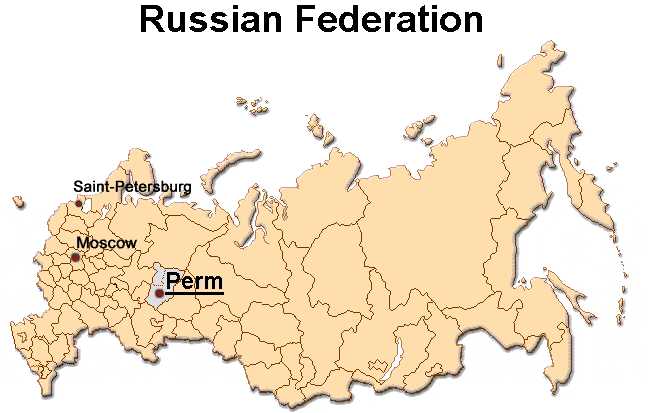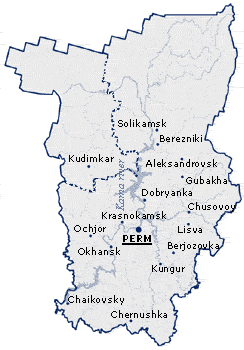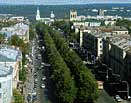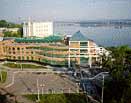|
(including former Komi-Permyatskiy autonomous district
with administrative centre in Kudimkar)
is one of the highly developed and prominent regions in Russia.
District: Privolzhskiy federal district
Economic region: Ural region
Territory: 160.6 thousand sq. km
Regional centre: Perm
Distance from Perm up to Moscow - 1100 km
Large cities: Perm, Berezniki, Solikamsk, Kungur, Lysva,Chusovoy.
Population - about 3 million residents
Geographical position
Natural resources
Industry
Agriculture
Transportation
External economic activity
Investments
Social sphere
This is the easternmost part of europe.
The Perm region is located on the western side of the Urals adjoining
to mountains from the west hilly plains.
Neighbours Ś Bashkortostan Republic, Udmurtiya Republic, Komi Republic,
Sverdlovsk region.
Komi-Permjacky autonomous region with administrative centre in Kudimkar
united in structure of the Perm region according to recent referendum.
The heart of the region is the city of Perm with the population exceeding
one million people.
Perm city is located on the banks of the river Kama, one of the largest
and most picturesque Russian rivers.
There are Kamsk and Votkinsk water basins.
The climate is moderately continental.
The average temperature of January is minus 15C, July plus 16C.
Perm region is located in zones of an average and southern taiga,
and also the mixed woods.
The principle wealth of the Perm region is its natural reserves.
Over 100 gas and oil fields provide 9,0 mln tons of oil and over 400 mln cbm
of natural gas.Oil and gas occupy a significant part in the fuel-energy complex.
A powerful oil refinery complex allows to produce an entire scope
of petroproducts. 8 heavy-duty pipelines criss-cross Prikamye and channel oil
and gas abroad and across Russia.
Over 1/3th of the world reserves is concentrated in a unique Verkhnekamsk
deposit of sodium, potassium and magnesium chlorides with a stock
of potassium oxide being assessed as 30 billion tons, which means 100%
extraction in the Russian Federation.
Along with potassium chlorides the deposit is rich in reserves of rock salts.
This precious wealth gave birth to a prominent mining and chemical complex.
The region manufactures over 700 kinds of chemicals.
Extraction and processing of non-ferrous and rare-earth metals as magnesium,
titanium, copper, chrome, lead, zinc, tin, aluminium, nickel, and precious
metals as gold and platinum are being carried out.
A diamond deposit in the basin of the Vishera river is being developed.
Thanks to the Vishera deposit the jewellery industry has blossomed up.
A substantial stock of mineral waters, especially hydrosulphuric, has been
prospected and is considered now a prominent resort place in Russia
called Ust-Kachka.
Vast timber resources of the Perm region have attributed to the region a status
of one of the leading timber industrial in Russia.
Wood cover over 60% of the area, amongst which 70% are coniferous.
The region supplies 3,0 mln cbm per year.
The natural resource map of the region can be complemented witha plentiful
of building materials like limestone, dolomite, gypsum, fire-resistant clay,
gravel, sand, along with decorative and trim stones(marble, granite,).
What distinguishes the regional energetics is a combination
of hydrothermoelectric power stations and heating plants.
The Perm region has got prominent timber reserves.
Wood cover over 60% of the area, amongst which 70% are coniferous.
The Perm region takes the first place in the Urals in water supply.
The Kama river is the main waterway which through the system of canals
provides the Perm river ports with access to five seas (the White, Azov,
Black, Caspian Seas).
The Perm region is a diversified industrial complex constituted of more
than 500 enterprises.
The segment of large and medium-sized companies covers approximately 90%
of the total regional output.
The industrial complex is based on
- Chemistry and petrochemistry (about 30% of Russian mineral fertilizers,
synthetic dyes,washing-up liquids, varnishes and paints are made in region),
- Fuel industry.Oil and gas occupy a significant part in the fuel-energy complex.
- Electric-power engineering. An important peculiarity of the electric power
engineering is a combination of hydro- and thermoelectric power stations as one
in a location of Dobryanka,the biggest 5,0 mln kWt power stations ever-built
in Russia.Over 40% of the electric power generated in the Perm region
is cruised to the neighbouring regions.
- Ferrous (bimetals, cold-rolled tin) and nonferrous metallurgy
(metal magnesium and its alloys).There is a unique regional manufacturer
of titanium sponge producing half of the Russian magnesium volume.
Powder metallurgy prospers as well.
- Machine building (represented by companies oriented at instrument
manufacture, machine-tool making, shipbuilding, aircraft industry, electrical
engineering,cable industry,aircraft and rocket engines,spaceship control gear
and wide rangeof consumer goods such as saws,excavators,electric and
gas stoves, diesel shunting locomotives, bicycles, pumps,electric motors,
enamelled kitchen ware,and other goods)
- Wood processing(business wood and saw-timbers, a paper, plywood,
a cardboard, wall-paper, fir oil etc). Pulp and paper industry is concentrated
along the Kama river which makestransportation easy.
Pulp and paper mills manufacture 20% of the total paper volume in Russia.
- Manufacture of building materials (cement, a brick, glass)
- Light industry(about 25% of Russian manufacture of silk fabrics, hosieries)
- Food industries (pasta, spirit food, sausage products, dairy production).
In 2000 the total number of the products manufactured by regional companies
reached more 110 billion roubles that is 112% comparing to the last year level.
The production growth was observed in machine-building, ferrous metallurgy,
chemical and petrochemical industries, light industry,
and manufacture of building materials.
The Perm region is related to the zone of risk-exposed agriculture.
Nonetheless, the level of the agricultural growth makes it possible
to satisfy up to 80-100% of the need of the population in essential
locally produced foodstuff.
The leading branch of agriculture is stock raising:
milk and meat cattle breeding, pig breeding,
poultry keeping, sheep and goat.
The livestock pedigreeing, milch cow farming, poultry,
and swine breeding have brought
the region included into the first ten in Russia.
Grain crops (rye, wheat, barley and oats) and vegetables are raised.
The area of 1 mln. hectare is planted with agricultural crops.
The Perm region is one of the heaviest transportation arteries of Russia.
Thanks to Kama river the region is lucky to have become the only one
in the Urals that has an access to five seas including Baltic and Black.
The annual river cargo turnover exceeds 5-mln tons/km.
Navigation is on Kama (the main ports - Perm, Solikamsk, Berezniki).
The Trans-Siberian railway opening an access to the European part
of the country and Siberia and the Far East crosses the region.
The total railway length runs 1,5 thousand-km.
Expansion of a network of firmly paved motor roads is in progress.
Annually, regional transportation and forwarding agencies and
self-employedbusinessmen transfer about 13 mln. tons of cargo.
The turnover of cargo transported by motor vehicles
reaches 340 mln. tons/km.
The regional transportation structure is composed of two airports ¢
local and republican. The Perm airport, having international status,
connects the region with 60 cities of the European and Eastern parts
of Russia. Besides Russian air-lines, the German company ōLufthansaö
arranges flights to Perm.
In the course of years the Western Ural used to be under a ban for
foreign visitors.
Today the Perm region is an active member of international trade and is
in communication with 130 countries. 420 companies perform foreign trade
operations with overseas partners. In 2000 the foreign trade turnover arrived
at 2108,9 mln. USD, with export and import shares being of 1818,8 mln.
USD and 289,9 mln USD respectively.
The export-import pattern of the Perm region remains relatively stable
for several years.
Products of fuel industry, chemistry with 25% of mineral fertilisers (potash
and nitrogenous fertilisers) constitute a major part of the regional export.
Cast iron, rolled metal, bimetal, ferroalloys, magnesium, titanium and
their alloys are actively exported as well.
The main accent in the timber export is laid onto lumber, plywood,
and newsprint supply.
For the sake of the smooth economic activity the Perm region has a
substantial remedy Perm Customs with a network of customs checkpoints.
The structure of the regional administration consists of the department
of international
and foreign economic relations; administrative bodies in regional
towns have analogous divisions and representations as well.
The investment potential of the Perm region is determined by several bright
features of the region that are geographical situation, economical stability,
richness in mineral resources,diversity of industries, significant scientific
and technical power, well-developed transportation infrastructure.
According to the investment rating the region ranks
the 7th - 8th among other Russian regions in terms of foreign investments.
For the period of 1994-2000 the total amount of foreign investments
counted 400 mln.USD.
On the territory of the region there have been incorporated over 360
alien-invested companies. Germany, USA, Italy, Great Britain, China,
France have gained the lead in establishment of joint ventures operating
in chemistry, petrochemistry, electrical engineering, machine-building,
metal-processing, wood-processing, pulp and paper industry, construction,
trade and public catering, tourism, science.
The Fourth Russian Venture Fair has held
in Perm on October 16-17, 2003.
The Perm region is a solid scientific and cultural centre.
60,0 thousand students attend 13 higher educational institutions.
The teaching staff of 330 doctors of science and
1700 candidates of science provides educational training in engineering
and technical sciences, the humanities and social occupations,
economics and management.
Scientific and industrial potential of the region is represented by such
centres of fundamental scientific research as the Perm Centre of the
Ural Department of the Russian Academy of Sciences, scientific and
research departments and design offices.
It is difficult to find any other region in Russia that has 10 professional
theatres.The largest one, the Opera and Ballet Theatre named after
P.I.Tchaikovskiy, is well known far beyond the region's boundaries.
The Perm Art Gallery with a unique collection of wooden sculpture,
the outdoor museum of Architecture and Ethnography in the village
of Khokhlovka,and the Ice Cave near the town of Kungur do deserve
to be named a fame of the region.
At present 11 local banks and 29 affiliates, including subsidiaries of
biggest national banks,are licensed to perform currency transactions
and are extensively experienced in international financial markets.
For the sake of external economic activity the Perm Chamber of
Commerce and Industry and the exhibition center ōPermskaya Yarmarkaö
have been founded.
More than 50 branches of traditional folk handcraft have still survived,
for instance, just few of them birch-bark braiding, wood carving, weaving,
stone cutting and pottery,lace making, etc.
NOTE: This page is composed using the materials of Perm sights
|




